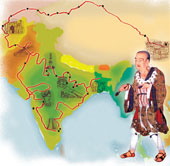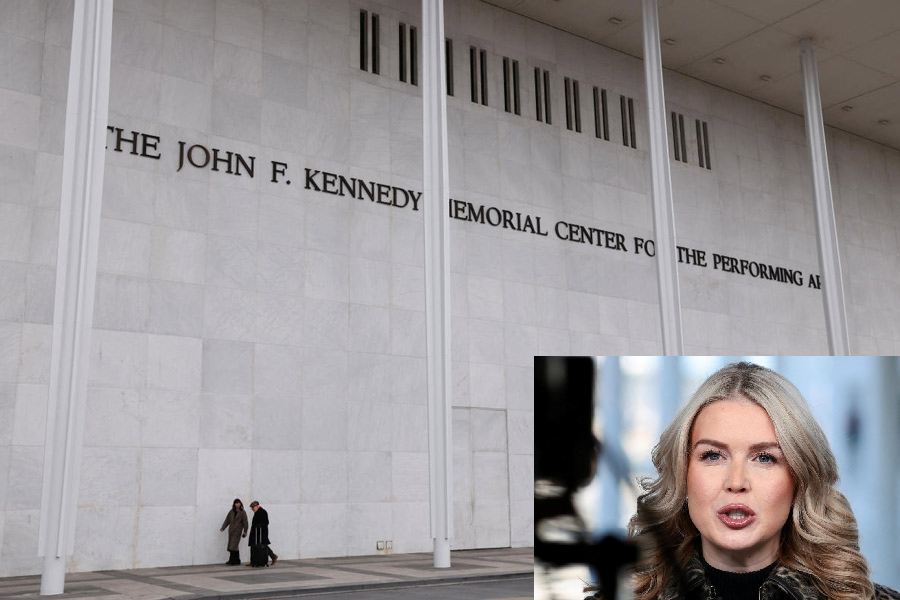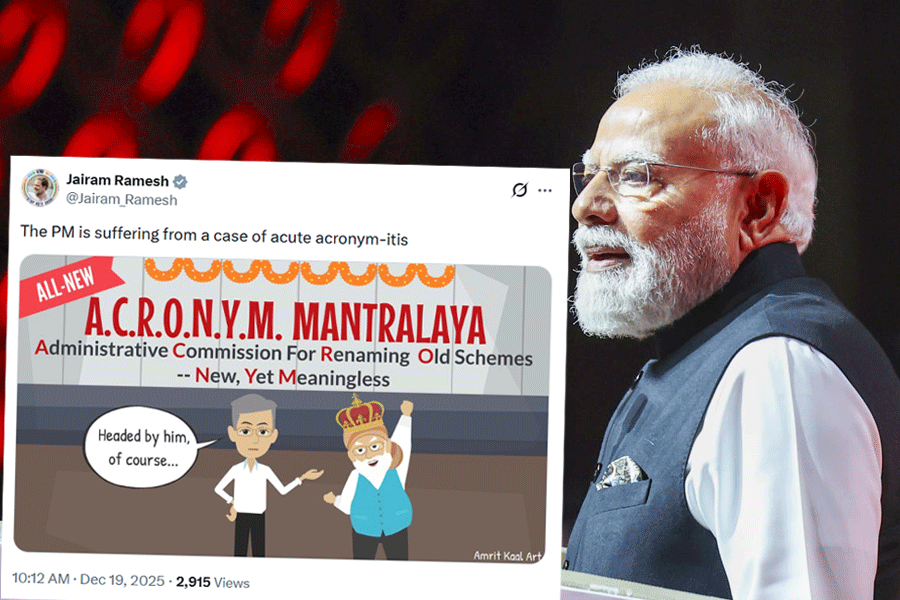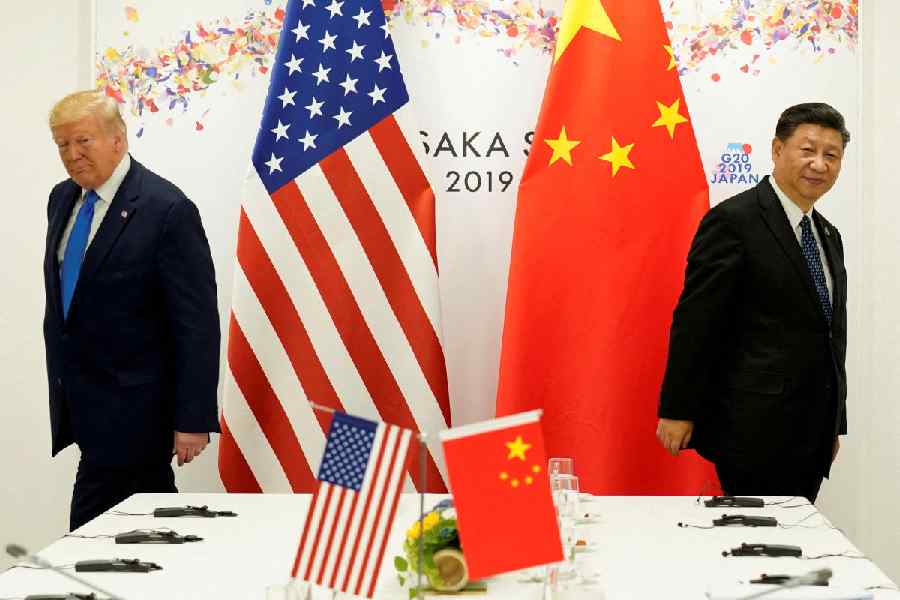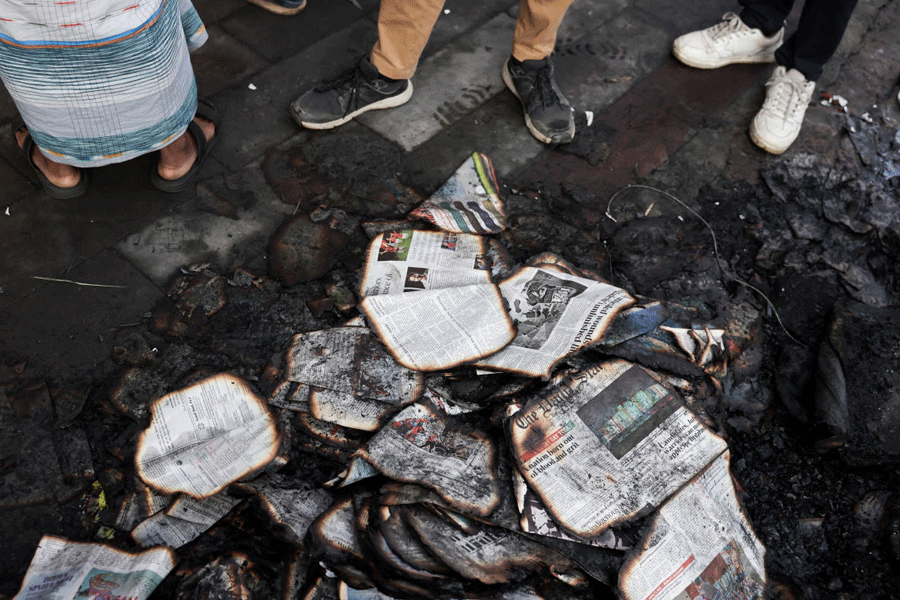 |
 |
 |
| IN THE MASTER?S FOOTSTEPS: (From top) Route taken by Sun Shuyun; a portrait of Hiuen Tsang; the cover of Shuyun?s book; the author (Pic: Rajesh Kumar) |
Legends are like mirages. They?re beautiful, wonderful images from afar, until you go nearer. And when you do, you reach a truth that is so different from the legend that you wonder how you believed in it in the first place.
Sun Shuyun?s Ten Thousand Miles Without A Cloud (HarperCollins) can best be termed as a woman?s journey, emerging from a legend and ending with her realising the whole truth. ?Without a cloud? is a metaphor in Chinese for the clarity of perfect knowledge. The seventh-century Chinese traveller Xuanzang ? or, as Indians know him, Hiuen Tsang ? travelled 10,000 miles hundreds of years ago in his quest for knowledge; for Shuyun, it was a quest for an identity, one that she was unsure of because she lived in conflicting times.
?I didn?t think I?d write a book when, in 2000, I retraced Xuanzang?s journey into India. For me, it was something that I had to do to find out why my grandmother had stuck to a belief all her life, even though it made her an outcast in her own house,? says the 42-year-old Shuyun, who lives in England, and works as a documentary filmmaker for BBC and Channel 4. Two years later, when she decided to write one after a meeting with an editor who was mesmerised by her description of her journey, ?I shut myself in a dark room, and the images passed in front of my eyes like a film,? says Shuyun, who was in India for a discussion on her book earlier this week.
The world has been equally fascinated by her imagery in her book. Amartya Sen ? with his insights on Sino-Indian relations ? said at the book-launch in London in July 2003: ?Get a copy, buy it, borrow it or steal it, whichever way, you have to read it. It?s a fantastic book, which has so many different dimensions that one doesn?t even know where exactly to begin.?
Shuyun says her pilgrimage can hardly be described as the arduous one that took the seventh-century monk 18 years to complete, travelling along the Silk Route under the harsh climes of the Taklamakan desert, the rough lands of Afghanistan, and the difficulties he faced in the Indian states. ?He was robbed countless times, and most of his entourage was killed by an avalanche. After a while, he would send a novice ahead of him with a bell, saying, ?We are Chinese monks who will teach you for free?,? she says. Finally, King Harshavardhana took Xuanzang under his wing, and the holy man spent years teaching at the Nalanda University till he went back to China in 641 AD.
Xuanzang?s journey took him to over 100 countries ? which are a part of six modern nations: China, Kyrgyzstan, Uzbekistan, Afghanistan, Pakistan and India. Shuyun, for her part, had her own hardships to face. While she travelled in the comparative comfort of modern transport such as planes, trains and coaches, her pilgrimage was left incomplete by her inability to procure a visa to go to Bamiyan, which was one of Xuanzang?s best-described sites of Buddhism.
?The Taliban was in power, and they told me I should only go there if I wanted it to be my last destination,? she says. She was also advised not to go to Uzbekistan, rocked by Islamic insurgents. So Shuyun took a plane from Bishkek in Kyrgyzstan to Islamabad in Pakistan, from where she went to Peshawar to continue her journey.
Just like her hero, she had her share of despair, too. In Nalanda University ? which she still believed matched up to its avatar in the Gupta era when Xuanzang taught there ? she found a total apathy to the ancient language and scripture courses. Like Xuanzang 13 centuries ago, she found very little by way of paved roads in modern Bihar, and was appalled by its poverty.
But what inspired her was how Xuanzang was an essential part of Indian history. ?I saw his frescoes in the Bodh Gaya temples, of monks with hemp shoes and chopsticks, like we have in China,? says Shuyun. She was also surprised by how Hiuen Tsang was a household name and a large part of history books in India.
Shuyun?s pilgrimage, however, started years before her actual journey. As she was growing up in the China of the Sixties, the cultural revolution was gaining momentum, and people followed the path set by Chairman Mao Zedong instead of Lord Buddha. ?Let me give you figures,? she says. ?In 1949, there were close to a quarter of a million Buddhist temples in China. After the end of the cultural revolution, there were barely a hundred,? she says. In school, she learnt,
Who is Buddha?
One clay body
With two black eyes
Three meals a day are wasted on him...
What should we do with him?
Smash him!
Shuyun?s father was a die-hard supporter of the Red Guards and had even joined the People?s Liberation Army in the Forties. Shuyun?s grandmother was a staunch Buddhist who was ridiculed by her son-in-law and granddaughter who thought she was stupid to be praying all the time. But Shuyun slept alongside her grandmother till she was 18 and found her nightly prayers disturbing and incomprehensible.
The one feeble bridge between her father?s blind faith in the revolution, and her grandmother?s belief in divine intervention was the legend of the Monkey King. It was the story of the monk Xuanzang, a weak and bumbling character ?with a mind as narrow as a chicken?s intestine?, who goes to India with a monkey, a pig and a novice to bring the sutras ? sacred Buddhist writings ? back with him.
In the story, it is not the monk but the monkey, blessed with supernatural powers, who returns with the sutras after 81 fierce battles. Her father approved of her reading the story because Mao loved it. ?It suited him to present Xuanzang, a Buddhist, in a negative light,? says Shuyun.
Her grandmother told her, ?In real life, the monk went on his own.? But Shuyun didn?t believe her. In all her years at school, she was taught a single paragraph about the real Xuanzang, that he was a monk who went to India. Shuyun kept on believing in the legend of the Monkey King until years later, when she was studying International Relations at Oxford, she happened to talk to an Indian classmate.
?Who is the most famous Chinese in India?? he asked. Unfazed she answered: ?Zhou En-Lai,? and he said no. She then said, ?Deng Xiaoping, for his involvement in Sino-Indian relations.? Her friend said it was Hiuen Tsang, her bumbling monk of Chinese legends, who was regarded as one of the most knowledgeable men in history ever to visit India.
Five years after her grandmother passed away in 1992, Shuyun?s father died, a broken man who then believed that all that he had stood for in his life was wrong, and that he had no alternative faith to follow. During these five years, Shuyun had read all she could about Xuanzang, and realised the greatness of the Chinese traveller who had gone to another land to be f?ted by its people. Her father?s death gave her a reason to rebel against his faith, that of Communism.
?I am not a Buddhist. But I felt I owed it to my grandmother, and my father?s lost faith, to undertake the pilgrimage,? she said. After universities reopened in China in 1976, Shuyun went to Beijing University, and then, Oxford. The Oxford library offered her enough material on Xuanzang ? and she read all that she could find. But reading wasn?t enough. It was when she went to Xian, Xuanzang?s hometown, that she met with monks who told her about the real significance of Xuanzang in China?s Buddhist culture. At the Wild Goose Pagoda there, Shuyun read the sutras that he had translated into Chinese.
That was when she decided to visit every place that the holy man had set foot on. This, she felt, would be her father?s vindication.
Three of the chapters in her book are entirely dedicated to her travels in India. The last chapter of the India section, called Nirvana, describes the last leg of Shuyun?s journey, from Benaras and Sarnath to Kushinagar, where the Buddha died, to Nalanda and Bodh Gaya, and finally to Ajanta via Kancheepuram, after which she went to Mumbai and boarded a Beijing-bound plane.
?We have a saying in China: What you find is not important, the way you find it is,? says Shuyun. She may not have been a true Communist, and she may not have discovered a true Buddhist in her yet, but Xuanzang helped her find herself. Sun Shuyun?s mind is now a clear blue sky. There is not a cloud anywhere.

